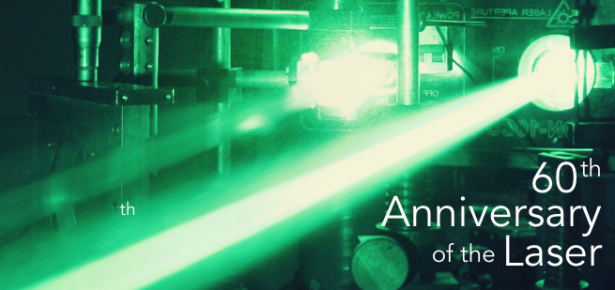
The laser (Light Amplification by Stimulated Emission of Radiation) can be thought of in the same way as any other oscillatory system; first put together a means whereby something of interest can be amplified. This basic component will produce some noisy version of the ‘something of interest’. However, if we feed some of this ‘something of interest’ back to the amplifying medium at a specific frequency then, with a little tuning to get enough feedback, the whole thing will oscillate. We’ve all, without realising it, done this. Think about pushing a youngster on a swing – exactly the same principles apply, but now you’re the feedback, and the input energy! The swing is the resonator – the ‘something of interest’ – and the youngster provides the ‘noise’ by randomly pushing the ground with their feet….
In the laser case: end mirrors are the feedback and a host of materials can provide the gain medium. To create the first working laser, on 16 May 1960, Ted Maiman used silver coated mirrors to provide the tuned feedback and ruby crystal to provide the gain with a photo flash gun as the pump. In December the same year the first gas laser – Helium Neon (He-Ne) – appeared. This is often used still in labs thanks to a safe power level and readily visible red light. Semiconductor lasers appeared in 1976. And the variations on the theme continue as the applications for laser become all the more pervasive. In parallel these innovations have been complemented by ever improving means of detecting light.
So what makes a laser so useful. Well, it makes light easy to focus down to a very small spot, and so it can generate potentially very large optical power densities. But – if you omit the lens – the light can often go in a straight line over very large distances. Another more subtle aspect of this is that the laser also produces light with a very stable optical wavelength which can, with some ingenuity, be used to measure distances with amazingly high precision (say around one millionth of the wavelength which is itself around one millionth of a metre!).
So here’s just a few examples of how we’ve now come to rely – often unknowingly – on the laser:
And the list goes on… It’s easy to find much, much more information on the web. There’s a recent (June 2019) issue of the trade magazine Photonics Spectra. And there are also numerous texts from the introductory to the specialist from Cambridge University Press, including …
The classic textbook Principles of Optics (60th Anniversary Edition published 2019) by Max Born and Emil Wolf ; Principles of Photonics, 2016 by Jia-Ming Liu; Christopher C. Davis’ Lasers and Electro-optics (2nd edition 2014);Attosecond and Strong-Field Physics, 2018 by C.D Lin Anh-Thu Le, Cheng Jin, and Hui Wei; Joseph Braat and Peter Török’s new classic Imaging Optics (2019);
And of course, my own, brand new, student resource: Introducing Photonics (Brian Culshaw, 2020).

Latest Comments
Have your say!